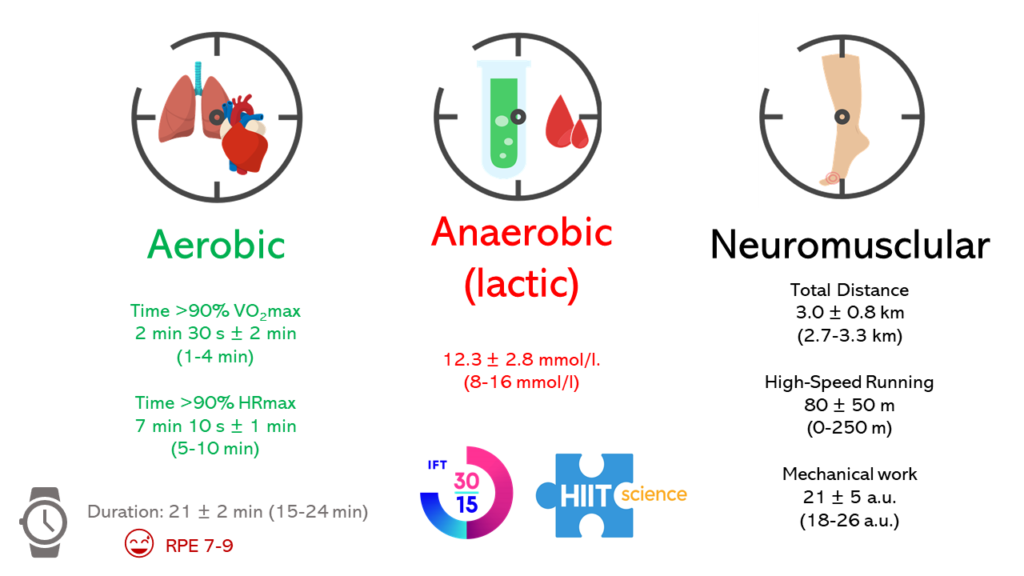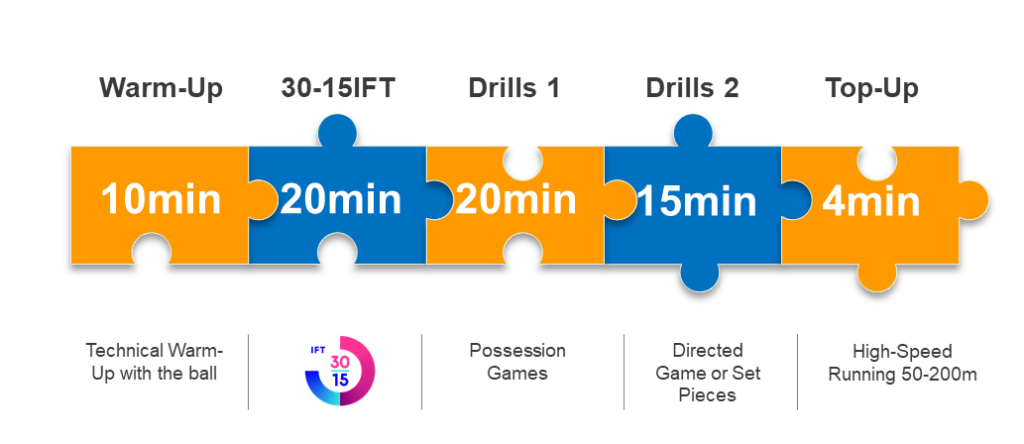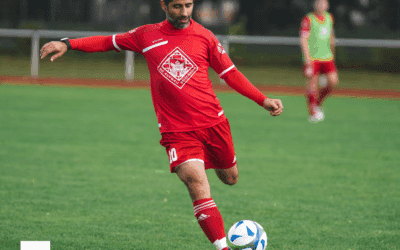
But a critical question for the practitioner remains: when is the best time to implement the 30-15IFT within the pre-season phase?In fact, there are typically two approaches that are considered. At first glance, it seems intuitive to test players first thing upon their return to the club after the break, which immediately allows a clear picture of a players’ fitness status so we can individualize their program. However, testing maximally after a long period of inactivity can be perceived as inappropriate for many reasons. First, exposing players to novel locomotor demands (high-speed running, changes of direction) can acutely increase injury risk. Second, since fitness may be compromised after a period of inactivity and is likely to improve quickly when returning to training, it can be argued that initial testing might not be relevant, with retesting required after 2-3 weeks. In elite teams however, it is often hard to fit in the testing due to the imposed demands and logistics of pre-seasons tours and friendly matches. Therefore, it’s difficult to find an optimal testing window, and solutions are likely team- and context-dependent. Therefore, another way to tackle this question may be to look at the actual metabolic and locomotor loads of the test and consider the best moment to integrate it into a players’ overall weekly load management and progression (10).
The aim of our paper, published in SPSR, was to describe a simple and effective way to program the 30-15IFT in relation to both session and weekly loads in an elite academy setting.
Metabolic and locomotor demands of the 30-15IFT
Following HIIT Science terminology (6), the metabolic and locomotor demands of the 30-15IFT (5) were classified on the basis of the 3 main physiological responses to HIIT, i.e., the aerobic energy contribution (inferred from oxygen consumption and heart rate), the anaerobic (lactic) energy production (inferred from blood lactate) and neuromuscular load (inferred from locomotor load including total distance (TD) covered, high-speed running (HSR) and mechanical work (MW), which represents a compound measure of accelerations, decelerations and changes of directions) (Figure 1) (6). The data were obtained from the existing literature (oxygen uptake and blood lactate) (11) and GPS data (Statsport, Apex, Newry, Ireland) from an elite soccer academy in France (n = 72 U17-U19 players with performance in the test ranging from 19 to 22 km/h). In addition, in a more qualitative way, the 180° changes of direction (COD) that must be performed at high speed during the last stages of the tests (i.e., >18-19 km/k, with the number of intense CODs depending on the final test performance) may also need to be considered in terms of load progression. Finally, for a better understanding of the 30-15IFT load in the context of actual soccer practice, these responses can be compared to those typically observed during both competitive matches and in-season conditioning sessions in professionals (Table 1) (12).
Figure 1. Physiological responses to the 30-15IFT based on the HIIT Science terminology (6), for an average test performance (peak speed reached, VIFT) of 19.5 km/h. HR: heart rate. TD: total distance. HSR: high-speed running (>19.8 km/h), MW: mechanical work, RPE: rate of perceived exertion (0-10 scale). The range of values provided are directly linked to test performance (i.e., the faster the VITF, the longer the test and the greater the load), but also reflect individual variability in the response to a similar VIFT
Table 1. Typical metabolic and locomotor responses observed during matches, typical in-season training sessions and the 30-15IFT in professional players.
Match demands are the team average, with the range accounting for player profile and position-related differences. The training session examples refer to the so-called conditioning-sessions, when a clear emphasis is put on a given physical capacity in relation to technical and tactical demands (12). D+3 Training: typical session with emphasis on neuromuscular (mechanical) work including several sequences of intense small-sided games with limited player numbers in small spaces (e.g. 4v4). D+4 Training: typical session with emphasis on endurance (prolonged possession games with at least 6v6 and then 8v8 players) and eventually short run-based HIIT. HR: heart rate. TD: total distance. HSR: high-speed running (>19.8 km/h), MW: mechanical work, sRPE: session rating of perceived exertion (0-10 scale). Sources: match lactate data: (13), HR and locomotor load: personal data and (12). Number in () or separated by – show value range.Programming the 30-15IFT during the pre-season period
The approach we suggest here is to integrate the load associated with the test (Figure 1) into to overall training load of both the session and the microcycle for which it is programmed (Figure 2), so that its metabolic and locomotor demands compliment that of the technical and physical workloads with respect to load dynamics and progression.Within-session load
It is clear that both the metabolic and locomotor demands of the 30-15IFT (Figure 1) are inferior to that of both matches and typical training sessions (irrespective of the well-known positional and player-profile differences) (Table 1).More precisely, performing the 30-15IFT represents a load that is equivalent to 1) 60-100% of the metabolic cost of many typical in-season training sessions (Table 1) when considering the time spent >90% of HRmax and maximal blood lactate values reached, but only 2) 30 to 50% of these sessions in terms of locomotor load (or even less in terms of HSR).In practice, this means that when a 30-15IFT is implemented during a session, coaches wishing to preserve their usual session’s physical load dynamics may not need to add technical/tactical situations that include a strong metabolic component within the same session (Figure 2). In contrast however, in terms of locomotor loads, there may be room for more work, in the range of 50 to 70% of typical sessions (depending on the type of session target, Table 1).
 Figure 2. Within-session example integrating the 30-15IFT. Drills 1: low-intensity possession games (with at least 6 to 8 players per team to decrease mechanical work. Drills 2: Tactical-oriented work such as directed games (the coach regularly stops the play to provide feedback to different player lines or different teams) or set pieces (for a TD of 3-4 km, no HSR and MW 20 a.u). Top up: additional 50-200m of HSR with low metabolic demands (HIIT Type 6 (6)) such as 2-4 x box-to-box runs within 12-15s interspersed with >30s of rest, with more repetitions for those not having performed above 19km/h at on the test.
Figure 2. Within-session example integrating the 30-15IFT. Drills 1: low-intensity possession games (with at least 6 to 8 players per team to decrease mechanical work. Drills 2: Tactical-oriented work such as directed games (the coach regularly stops the play to provide feedback to different player lines or different teams) or set pieces (for a TD of 3-4 km, no HSR and MW 20 a.u). Top up: additional 50-200m of HSR with low metabolic demands (HIIT Type 6 (6)) such as 2-4 x box-to-box runs within 12-15s interspersed with >30s of rest, with more repetitions for those not having performed above 19km/h at on the test.
Weekly cycle load dynamic
The second step of the approach is to build the microcycle and program the weekly load dynamics to allow an optimal inclusion of the 30-15IFT within the technical soccer specific sessions (Figure 3). While there are as many options as there are contexts (e.g., population, age, playing standards, number of sessions, duration of the off-season break) we offer here an example for a team of highly trained academy players performing 7 pitch sessions during their two first pre-season weeks (together with a few gym-based sessions). As shown in Figure 2, in this specific context, the 30-15IFT was programmed during week 1 of the pre-season, but the same logic would apply if it was to be programmed during week 2 or 3.The locomotor load of the 30-15IFT (pink arrows and circle) represents only a portion of the D4 session load, with the test being used to introduce both the first bouts of HSR and intense 180° CODs.Note the reduced session load on D3, which is aimed at helping players gain freshness for the testing day on D4. Overall, the programming of the microcycle allows for a progressive locomotor loading throughout the week, especially via the alteration of MW and HSR loads (i.e., when the emphasis is on MW, HSR is decreased, and conversely, see D6 vs. D7).
 Figure 3. Heart rate and locomotor load responses (with standard deviations) to the 7 pitch sessions of a first week microcycle in an elite academy. Non-pitch-based gym sessions were also programmed on some but not all days. The actual load of sessions 1-3 can be considered as low-to-moderate (low sRPE) in relation to typical in-season sessions (Table 1). The 30-15IFT was programmed on D4. The proportion of the session that arises from the 30-15IFT is shown by the pink arrows and circle. TD: total distance. HSR: high-speed running (>19.8 km/h), MW: mechanical work, sRPE: session rate of perceived exertion (0-10 scale). The main specific session contents are shown on the top of each day. SSG: small-sided games. Type 4 HIIT refers to the following HIIT Science terminology (6), and specifically to a sequence that involves a high contribution of both the aerobic and anaerobic (lactic) systems together with a strong neuromuscular load.
Figure 3. Heart rate and locomotor load responses (with standard deviations) to the 7 pitch sessions of a first week microcycle in an elite academy. Non-pitch-based gym sessions were also programmed on some but not all days. The actual load of sessions 1-3 can be considered as low-to-moderate (low sRPE) in relation to typical in-season sessions (Table 1). The 30-15IFT was programmed on D4. The proportion of the session that arises from the 30-15IFT is shown by the pink arrows and circle. TD: total distance. HSR: high-speed running (>19.8 km/h), MW: mechanical work, sRPE: session rate of perceived exertion (0-10 scale). The main specific session contents are shown on the top of each day. SSG: small-sided games. Type 4 HIIT refers to the following HIIT Science terminology (6), and specifically to a sequence that involves a high contribution of both the aerobic and anaerobic (lactic) systems together with a strong neuromuscular load.
Practical applications
- It is important to take the metabolic and locomotor demands of the 30-15IFT into consideration when planning its integration into both a session and the weekly microcycle.
- When the 30-15IFT is introduced during a technical session, the soccer-specific sequences that follow the test may not need the involvement of more metabolic conditioning, but could rather include more locomotor loads in the range of 50-70% of usual sessions (together with a bit of non-metabolic HSR, especially for those with a test performance <19 km/h).
- The programming of the 30-15IFT during the weekly cycles when returning to training (1st 2nd vs. 3rd week) is directly related to the team context and training plan (e.g., how many sessions a week) but it should first fit into the overall locomotor load progression, especially in terms of mechanical work and CODs at high speeds.
Conclusion
The programming of the 30-15IFT during the first weeks of the pre-season needs to take into account the metabolic and locomotor loads of the test, with practitioners invited to tailor the overall training session in order to maintain an appropriate progressive loading during the training week.About the authors
Buchheit1,2 & M. Brown2 1Myorobie Performance, Montvalezan, France 2Performance Department, Paris Saint Germain, FranceReferences
- Buchheit, M. and P.B. Laursen, High-intensity interval training, solutions to the programming puzzle: Part I: cardiopulmonary emphasis. Sports Med, 2013. 43(5): p. 313-338.
- Leger, L.A. and R. Boucher, An indirect continuous running multistage field test: the Universite de Montreal track test. Can J Appl Sport Sci, 1980. 5(2): p. 77-84.
- Leger, L.A. and J. Lambert, A maximal multistage 20-m shuttle run test to predict VO2 max. Eur J Appl Physiol Occup Physiol, 1982. 49(1): p. 1-12.
- Bangsbo, J., F.M. Iaia, and P. Krustrup, The Yo-Yo intermittent recovery test : a useful tool for evaluation of physical performance in intermittent sports. Sports Med, 2008. 38(1): p. 37-51.
- Buchheit, M., The 30-15 Intermittent Fitness Test: accuracy for individualizing interval training of young intermittent sport players. J Strength Cond Res, 2008. 22(2): p. 365-374.
- Laursen, P.B. and M. Buchheit, Science and Application of High-Intensity Interval Training (HIIT): Solutions to the Programming Puzzle. 2018: Human Kinetics; First edition (December 28, 2018). 664.
- Buchheit, M. and A. Mendez-Villanueva, Supramaximal intermittent running performance in relation to age and locomotor profile in highly-trained young soccer players. Journal of Sports Sciences, 2013. 31(13): p. 1402-11.
- Buchheit, M., Individualizing high-intensity interval training in intermittent sport athletes with the 30-15 Intermittent Fitness Test. NSCA Hot Topic Series. www.nsca-lift.org, 2011. November.
- Buchheit, M., The 30-15 Intermittent Fitness Test : 10 year review. Myorobie Journal 2010. 1(September): p. http://www.martin-buchheit.net
- Buchheit, M., Programming high-speed running and mechanical work in relation to technical contents and match schedule in professional soccer. Sport Performance & Science Reports, 2019(64): p. v1.
- Buchheit, M., et al., Cardiorespiratory responses during running and sport-specific exercises in handball players. J Sci Med Sport, 2009. 12(3): p. 399-405.
- Buchheit, M., et al., Neuromuscular responses to conditioned soccer sessions assessed via GPS-embedded accelerometers: insights into tactical periodization. Int J Sports Physiol Perform, 2017: p. Sep 5:1-21. doi: 10.1123/ijspp.2017-0045. [Epub ahead of print].
- Bangsbo, J., F.M. Iaia, and P. Krustrup, Metabolic response and fatigue in soccer. Int J Sports Physiol Perform, 2007. 2(2): p. 111-27.
- Lacome, M., et al., Small Sided Games in elite soccer: Does one size fits all? Int J Sports Physiol Perform, 2018. 13(5): p. 568-576.







